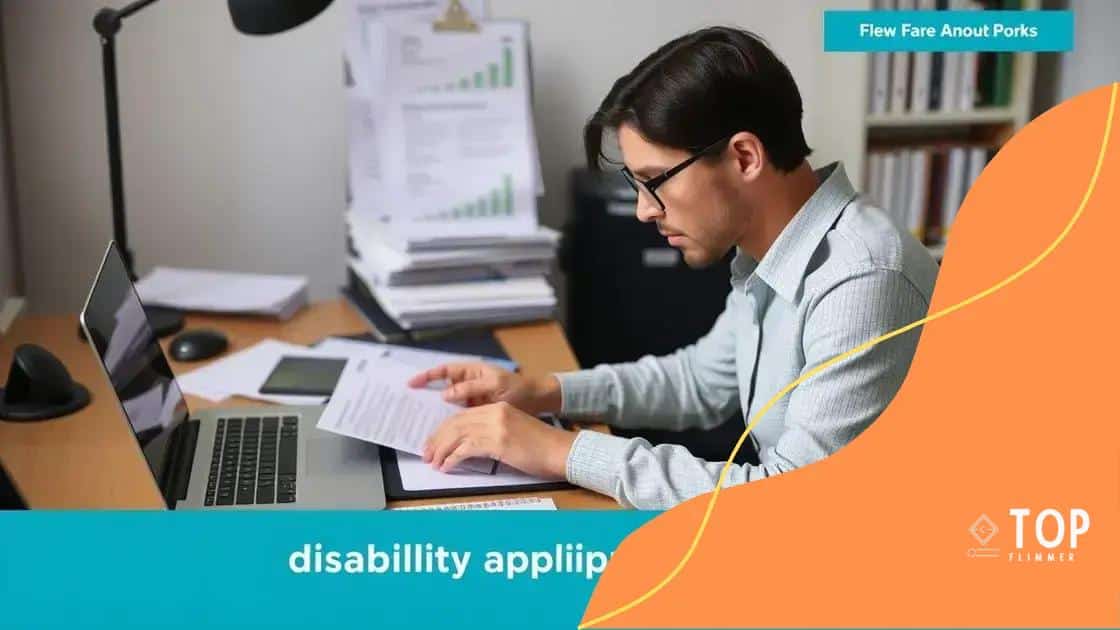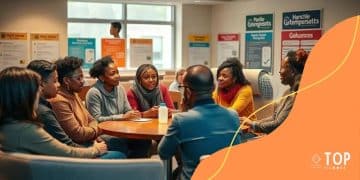Reworking disability application processes for better access

Reworking disability application processes through technology and best practices significantly enhances accessibility, reduces complexities, and improves overall applicant experiences by streamlining submissions and providing necessary support.
Reworking disability application processes is essential for enhancing accessibility and efficiency. Have you ever wondered how small changes can make a big difference for those in need? Discover how we can streamline these processes to benefit applicants.
Understanding the current disability application process
Understanding the current disability application process is crucial for those seeking assistance. It can seem overwhelming, but breaking it down helps clarify what’s involved. Many applicants feel lost at the beginning, so let’s explore the main steps together.
Steps to Apply for Disability Benefits
The application process typically starts with gathering the necessary documents. This includes medical records, work history, and identification. Once you have everything ready, you submit your application either online or in person.
- Gather personal information and documents.
- Complete the application form accurately.
- Provide supporting documentation.
- Submit the application through the right channels.
Next comes waiting for the decision. This may take several weeks or months. In some instances, applications can be denied, which often adds frustration. However, understanding the appeals process is vital for moving forward.
The Role of Medical Evidence
Medical evidence plays a significant role in the decisions made during this process. When determining eligibility, the disability office reviews the medical documents you submit. Having clear, detailed, and relevant evidence can greatly influence their judgment. It’s important not just to have this evidence but to ensure it supports your claim effectively.
Furthermore, keeping open communication with your healthcare providers can help ensure all necessary documentation is provided promptly. This proactive approach can alleviate stress and contribute to a smoother process.
Common Challenges Applicants Face
Many applicants encounter challenges during their journey. Some of the most common issues include:
- Confusion about the details of the application.
- Gathering the required medical evidence.
- Understanding the jargon used in forms.
- The length of time taken for a response.
Knowing these challenges ahead of time can help applicants prepare more effectively. By addressing these issues, you improve your chances of success.
In summary, understanding the current disability application process helps demystify what’s often seen as a daunting task. By taking these steps and being informed, applicants can navigate the process with greater confidence.
Identifying the common challenges faced by applicants
Identifying the common challenges faced by applicants is key to improving the experience for those seeking disability benefits. Many people enter this process unaware of the hurdles that await them. By understanding these challenges, applicants can be better prepared.
Challenges in the Application Process
One major challenge is gathering all the necessary documentation. Many applicants struggle to collect medical records and other important information. It can feel overwhelming, especially when navigating through complex medical details. Additionally, understanding the forms can be difficult.
- Confusing legal and medical terminology.
- Lengthy application forms that require attention to detail.
- Need for extensive medical evidence.
- Difficulty in understanding eligibility criteria.
An often overlooked challenge is the emotional toll that the process can take. Waiting for a decision can cause significant anxiety. Many applicants feel uncertain about their future during this time, which can heighten stress levels.
Communication Barriers
Another obstacle is communication barriers. Some applicants may find it hard to reach out to officials or understand the feedback they receive. If applicants do not have access to assistance, their chances of successfully completing the application decrease.
Moreover, applicants often find themselves dealing with delays in processing times. This waiting period can last for months, and many people do not realize that appeals can add even more time. Recognizing these delays helps applicants manage their expectations.
Addressing these challenges requires awareness. By understanding the common difficulties, applicants can approach the process with realistic expectations and seek help when necessary. Knowledge is power for those navigating the disability application landscape.
Best practices for improving the application experience

Implementing the best practices for improving the application experience can significantly help applicants navigate the disability process. Understanding how to effectively manage the submission can lead to better outcomes.
Clear Documentation
First and foremost, gather all necessary documentation before starting your application. This includes medical records, identification, and any prior correspondence with disability services. Having everything ready can streamline the submission process and prevent unnecessary delays.
- Check for up-to-date medical records.
- Ensure personal information is correct.
- Prepare a checklist of required documents.
- Organize materials for easy access.
Another important aspect is understanding the application forms. Many applicants find them confusing, leading to errors. Take the time to read instructions carefully and seek clarification if needed.
Stay Informed and Follow Up
Staying informed about the application status can also improve the experience. After submitting, don’t hesitate to follow up with the disability office. This shows that you are engaged and can help speed up the process.
Be aware of timelines associated with decisions. Knowing how long the process may take can help manage expectations. It’s recommended to keep a record of all communications for future reference.
Seek Support
Lastly, don’t shy away from seeking support. Many organizations offer help specifically for applicants going through the disability process. They can provide resources and guidance, making the process less daunting.
- Look for support groups in your area.
- Contact local advocacy organizations.
- Utilize online resources for additional guidance.
- Ask friends or family for support during the process.
By adopting these best practices, applicants can navigate the complex world of disability applications with increased confidence and less stress.
The role of technology in simplifying applications
The role of technology in simplifying applications is a game changer for individuals navigating the disability process. With advancements in tech, applying for benefits has become more user-friendly and efficient.
Online Application Portals
Many organizations now offer online application portals. These platforms allow applicants to fill out forms, upload documents, and track their application status from the comfort of their homes. This access is especially beneficial for those with mobility challenges.
- Ease of access from any device.
- Real-time status updates on applications.
- Simplified document upload functionalities.
- Reduction in paper use and associated fees.
By using an online portal, applicants can save time and reduce errors that often occur with paper forms.
Utilizing Mobile Apps
Mobile applications are also making a significant impact. Many organizations have developed apps specifically designed for applicants. These apps can send reminders, provide guidance, and offer resources to help individuals through each step.
Having a dedicated mobile solution means you can have assistance at your fingertips. This can alleviate stress during crucial times.
Telehealth Services
Furthermore, telehealth services are revolutionizing access to medical consultations. Instead of scheduling in-person visits, applicants can connect with healthcare providers via video calls. This approach not only saves travel time but also makes it easier to gather necessary medical evidence.
This convenience ensures that applicants have the documentation they need without unnecessary delays. Overall, technology provides immense support in navigating the application process more smoothly.
By embracing these technological advancements, applicants can feel more empowered and informed, leading to higher chances of success.
Real-life examples of successful process changes
Real-life examples of successful process changes in disability applications highlight the positive impact of strategic improvements. Many organizations have made significant progress in simplifying their processes, leading to successful outcomes for applicants.
Case Study: Streamlined Application Systems
One disability services organization implemented a new application system that allowed online submissions. This change not only shortened processing times but also increased the completion rate of applications. By reducing paperwork, they made it easier for applicants to provide the necessary information, leading to more accepted claims.
- Reduced processing time from months to weeks.
- Increased user satisfaction scores significantly.
- Higher overall approval rates due to fewer errors.
- Streamlined communication between applicants and staff.
Such improvements demonstrate how technology can genuinely enhance the experience for applicants.
Case Study: Enhanced Support Services
Another example involves a nonprofit organization that focused on providing support services to applicants. They created a dedicated help desk with trained staff to assist applicants and answer their questions. This change resulted in increased applicant confidence and decreased frustration during the application process.
As a result, there was a marked decrease in application denial rates due to lack of information. Applicants felt more supported and empowered, leading to a better overall experience.
Case Study: Integrating Community Feedback
A third case study highlights an agency that actively sought out feedback from applicants regarding their experiences. By hosting focus groups and surveys, they gathered insights that informed process changes. This feedback loop led to adjustments in language used in applications and better clarity on eligibility criteria.
Such initiatives not only improved the application process but also built trust with the community, resulting in increased engagement and participation.
These real-life stories shed light on the tangible benefits of making positive changes within the disability application framework. Lessons learned from these examples can inspire other organizations to adopt similar practices.
In summary, reworking the disability application processes can lead to significant improvements in accessibility and efficiency. By embracing technology, understanding common challenges, and implementing best practices, organizations can greatly enhance the applicant experience. Real-life examples show how effective these changes can be, offering inspiration for others. Empowering applicants with support and clear information is essential for a smoother and more successful process. Together, we can create a more equitable system for everyone seeking assistance.
FAQ – Frequently Asked Questions about Reworking Disability Application Processes
What are the common challenges faced by applicants?
Applicants often face challenges like gathering required documents, understanding complex forms, and experiencing long waiting times for decisions.
How can technology improve the application experience?
Technology simplifies submissions through online portals and mobile apps, making it easier for applicants to track their status and connect with support.
What best practices can applicants follow?
Applicants can benefit from gathering all necessary documents in advance, seeking help when needed, and keeping track of their application status.
Why are real-life examples important?
Real-life examples show successful process changes that can inspire other organizations to implement similar improvements, enhancing the overall applicant experience.






